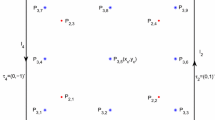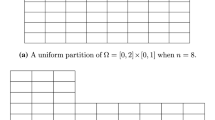Abstract
The main objective of this paper is to present a new rectangular nonconforming finite element scheme with the second order convergence behavior for approximation of Maxwell’s equations. Then the corresponding optimal error estimates are derived. The difficulty in construction of this finite element scheme is how to choose a compatible pair of degrees of freedom and shape function space so as to make the consistency error due to the nonconformity of the element being of order O(h 3), properly one order higher than that of its interpolation error O(h 2) in the broken energy norm, where h is the subdivision parameter tending to zero.
Similar content being viewed by others
References
Ciarlet, P.G. Basic Error Estimates for Elliptic Problems. In: Handbook of Numerical Analysis, Vol.2-Finite Element Methods (pt.1), NorthHolland, Amsterdam, 1991
Chen, S.C., Shi, D.Y. Accuracy analysis for Quasi-Wilson element. Acta Math. Sci., 20(1): 44–48 (2000)
Chen, S.C., Shi, D.Y., Zhao, Y.C. Anisotropic interpolation and quasi-Wilson element for narrow quadrilateral meshes. IMA. J. Numer. Anal., 24(1): 77–95 (2004)
Deng, M., Shen, G.S., Yu, P., Deng, J.W. The marine magnetotelluric prospecting technique based on the Maxwell’s theory. Ocean. Technology, 22(2): 44–47 (2003)
Jiang, J.J., Cheng, X.L. A nonconforming element like Wilson’s for second order problems. Math. Numer. Sinica, 14(3): 274–278 (1992)
Lin, Q., Yan, N.N. Global superconvergence for Maxwell’s equations. Math. Comput., 69(229): 159–176 (1999)
Lin, J.F., Lin, Q. Global superconvergence of mixed finite element methods for 2-D Maxwell’s equations. J. Comput. Math., 21(5): 637–646 (2003)
Lin, Q., Lin, J.F. Finite Element Methods: Accuracy and Improvement. Mathematics Monograph Series 1. Science Press, Beijing, China, 2006
Ledger, P.D., Morgan, K., Hassan, O., Weatherill, N.P. Plane wave H(curl; Ω) conforming finite elements for Maxwell’s equations. Comput. Mech., 31(3): 272–283 (2003)
Monk, P. A mixed method for approximating Maxwell’s equations. SIAM J. Numer. Anal., 28(6): 1610–1634 (1991)
Monk, P. A comparison of three mixed methods for the time-dependent Maxwell’s equations. SIAM J. Sci. Statist. Comput., 13(5): 1097–1122 (1992)
Monk, P. Analysis of a finite element method for Maxwell’s equations. SIAM J. Numer. Anal., 29(3): 714–729 (1992)
Monk, P. Superconvergence of finite element approximation to Maxwell’s equations. Numer. Meth. for PDEs., 10(6): 793–812 (1994)
Maria, L.M., Jitka, S., Gerald, W., Yousef, Z. On evolution Galerkin methods for the Maxwell’s and the linearized Euler equations. Appl. Math., 49(5): 415–439 (2004)
Nedelec, J. Mixed finite elements in R 3. Numer. Math., 35: 315–341 (1980)
Robert, L.L., Niel, K.M. A mixed finite element formulation for Maxwell’s equations in the time domain. J. Comput. Phys., 88: 284–304 (1990)
Shi, D.Y., Pei, L.F. Low order Crouzeix-Raviart type nonconforming finite element methods for approximating Maxwell’s equations. Int. J. Numer. Anal. & Model., 5(3): 373–385 (2008)
Shi, D.Y., Mao, S.P., Chen, S.C. An anisotropic nonconforming finite element with some superconvergence results. J. Comput. Math., 23(3): 261–274 (2005)
Specht, B. Modified shape functions for the three node plate bending element passing the patch-Test. Int. J. Numer. Meth. Engrg., 26(3): 705–715 (1988)
Shi, Z.C., Chen, S.C. An analysis of a nine degree plate bending element of specht. Acta. Numer. Math., 11(3): 312–318 (1989)
Shi, D.Y., Pei, L.F., Chen. S.C. A nonconforming arbitrary quadrilateral finite element method for approximating Maxwell’s equations. Numer. Math. J. Chinese Univ., 16(4): 289–299 (2007)
Author information
Authors and Affiliations
Corresponding author
Additional information
Supported by the National Natural Science Foundation of China (No. 10971203), and the Doctor Foundation of Henan Institute of Engineering (No. D09008).
Rights and permissions
About this article
Cite this article
Shi, Dy., Hao, Xb. A second order nonconforming rectangular finite element method for approximating Maxwell’s equations. Acta Math. Appl. Sin. Engl. Ser. 27, 739–748 (2011). https://doi.org/10.1007/s10255-011-0103-9
Received:
Revised:
Published:
Issue Date:
DOI: https://doi.org/10.1007/s10255-011-0103-9
Keywords
- Maxwell’s equations
- rectangular nonconforming element
- second order convergence behavior
- error estimates




